A dash cam is a small recording device used in a car that automatically captures videos of the road when you are driving.
Dash cam videos provide evidence to determine fault in a car accident, help to clear up disputes and file insurance claims more easily, and may even help deter criminal behavior.
How Does a Dash Cam Store Video Footage
A dash cam usually stores footage on a removable microSD card or USB drive. Since the storage space is limited, to ensure your dash cam is always recording the latest footage, most dash cams use a loop recording system.
That is, when the card becomes full, the oldest videos will be automatically deleted and replaced with new footage.
However, certain videos will not be overwritten. Many dash cams can detect sudden impacts or emergency braking and automatically mark the footage as emergency videos, preventing it from being deleted. Some users can also manually lock important recordings to keep them safe.
What’s more, some advanced dash cams offer a cloud storage feature that automatically uploads videos to the cloud.
Nevertheless, dash cam footage can sometimes get lost. Here is a true example:
“Yesterday I accidentally deleted all footage from my Nextbase 320XR by pressing format SD card. I lost someone very close to me recently that was in my car a lot, and I wanted to listen back to conversations we had. I have no clue how to get it back. Please help.”Reddit.com
Before moving on to the dash cam video recovery steps, let me introduce the common reasons why dash cam videos are missing.
What Causes Dash Cam Video Loss
Dash cam footage loss is commonly caused by the dash cam data storage method, card issues, human factors, power supply problems, and technical glitches:
- Overwriting: Most dash cams use a continuous loop recording method. When the memory card is full, the camera automatically starts deleting the oldest files to free up space for new ones.
- Accidental deletion: Mistakes when watching or managing videos can cause important clips to be deleted by accident.
- Disk formatting: If the SD card or USB drive is mistakenly formatted, all videos stored on it will be completely deleted.
- Card corruption or damage: The card can be logically corrupted or physically damaged due to sudden power loss, improper ejection, or wear and tear. This can make the files deleted or inaccessible.
Once files are overwritten or the memory card is physically damaged, your videos usually cannot be recovered unless you have a backup.
However, in other cases like accidental deletion, formatting, or file system corruption, there is a good chance to recover deleted videos from a dash cam.
Now, let’s explore how to do that in detail.
How to Recover Dash Cam Videos
To recover lost or deleted dash cam videos, first stop using the SD card or USB drive immediately to prevent overwriting the lost footage.
Next, check your cloud storage, external hard drive, computer, or phone for the missing files. If you do not have a backup, promptly use free data recovery software to scan your drive and recover the files.
If you are unable to recover deleted dash cam footage by yourself, seek help from a professional data recovery service.
Now, follow the detailed instructions below.
Way 1. Check Backup Files
To save time and effort, start by checking whether your footage has been backed up somewhere. Some dash cams can automatically upload videos to the cloud via a Wi-Fi connection, but in most cases, you need to back them up manually.
So, think back, have you ever saved your clips to Google Drive, an external hard drive, or transferred them to your phone using the dash cam’s dedicated app?
If you do not find your videos there, the next step is to use professional data recovery software to scan your drive for lost footage.
Way 2. Use Data Recovery Software
If you do not have a reliable data restore tool to recover dash cam videos, you can try MiniTool Power Data Recovery. It is 100% safe and robust, with the following features:
| Supported storage devices | SD cards, USB drives, HDDs, SSDs, etc. |
| Supported file types | Videos, photos, documents, audio, archives, etc. |
| Supported file systems | FAT32, exFAT, NTFS, Ext2, Ext3, Ext4, etc. |
| Supported data recovery scenarios | Accidental deletion, partition loss, drive corruption, virus infection, disk formatting, etc. |
| OS compatibility | Windows 11/10/8/8.1 |
| Free edition | Free file preview and 1 GB of free data recovery |
| Ease of use | Simple recovery steps with intuitive interface |
Now, get the free edition of this recovery tool and launch it to recover your dash cam videos.
MiniTool Power Data Recovery FreeClick to Download100%Clean & Safe
Before recovering files, connect your SD card or USB drive to your computer.
Step 1. Scan the SD card or USB drive.
On the home page of the recovery software, select your SD card or USB drive partition, which is marked with a USB icon, and click the Scan button.
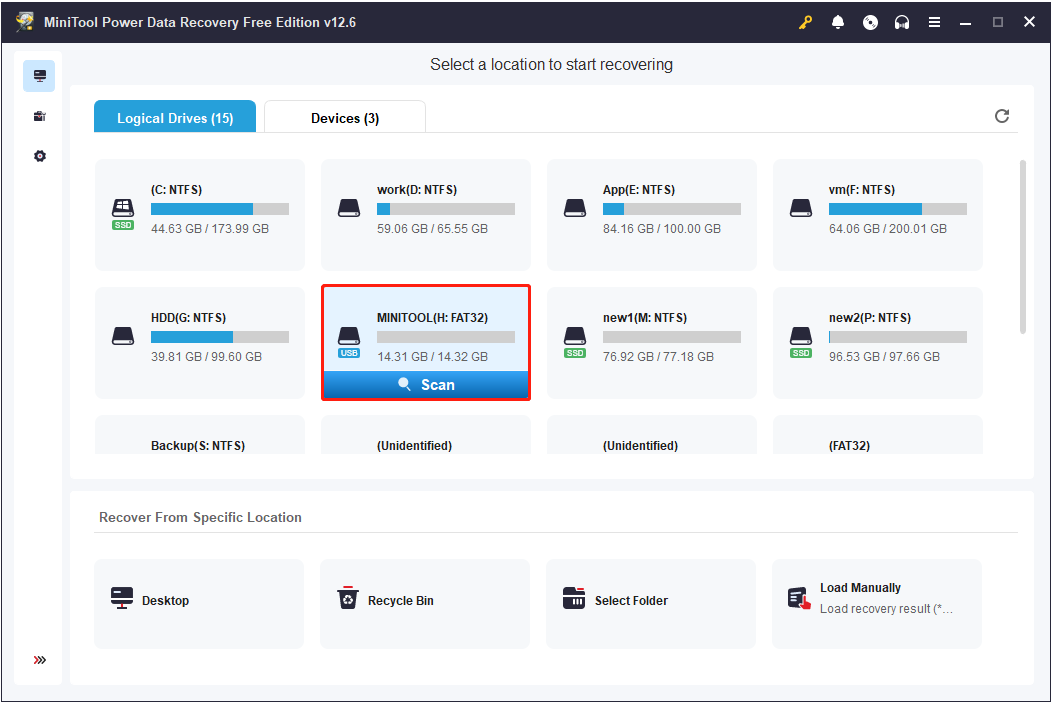
The software will start to scan the selected drive for lost, deleted, and existing files. To get complete results, wait for it to finish automatically.
Step 2. Find and preview desired videos.
Once the scan is finished, locate your videos under Path or Type.
- Path: Expand each folder to find your videos.
- Type: Go to the Audio & Video section and look for common dash cam video formats such as .mov or .mp4.

Additionally, you can use Filter or Search to locate your footage more quickly:
- Filter: Narrow down files by type, modification date, size, or category.
- Search: Find specific files using a full or partial file name. Dash cam videos often include the year and date in their file names, so you can try searching by year like 2025.
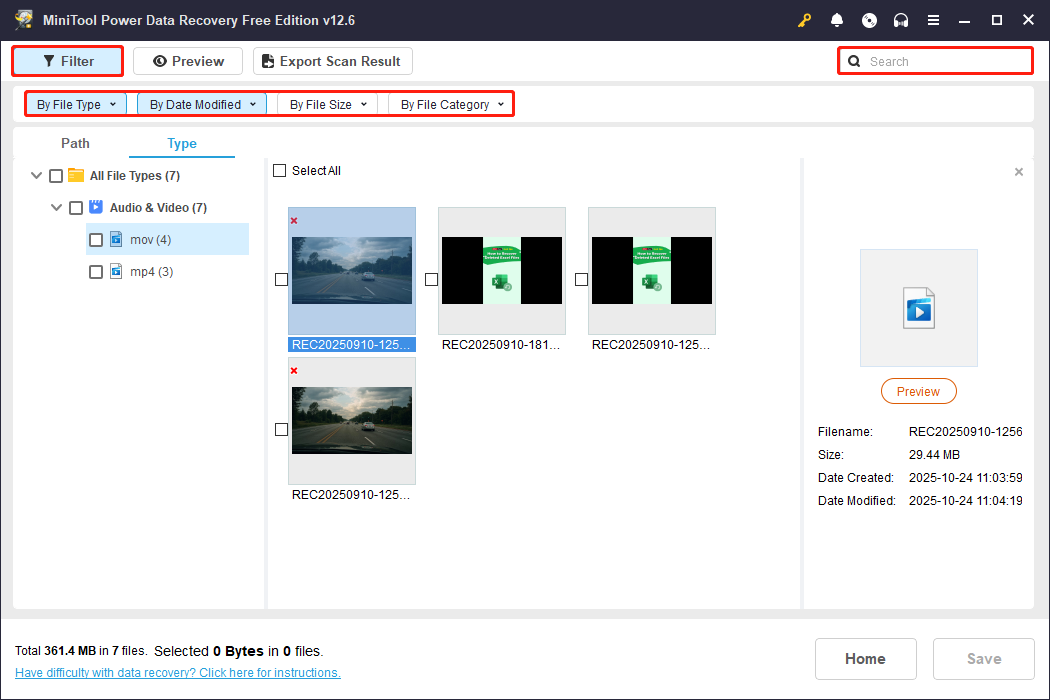
To avoid wasting the 1 GB of free data recovery capacity, double-click on each desired file to preview it.
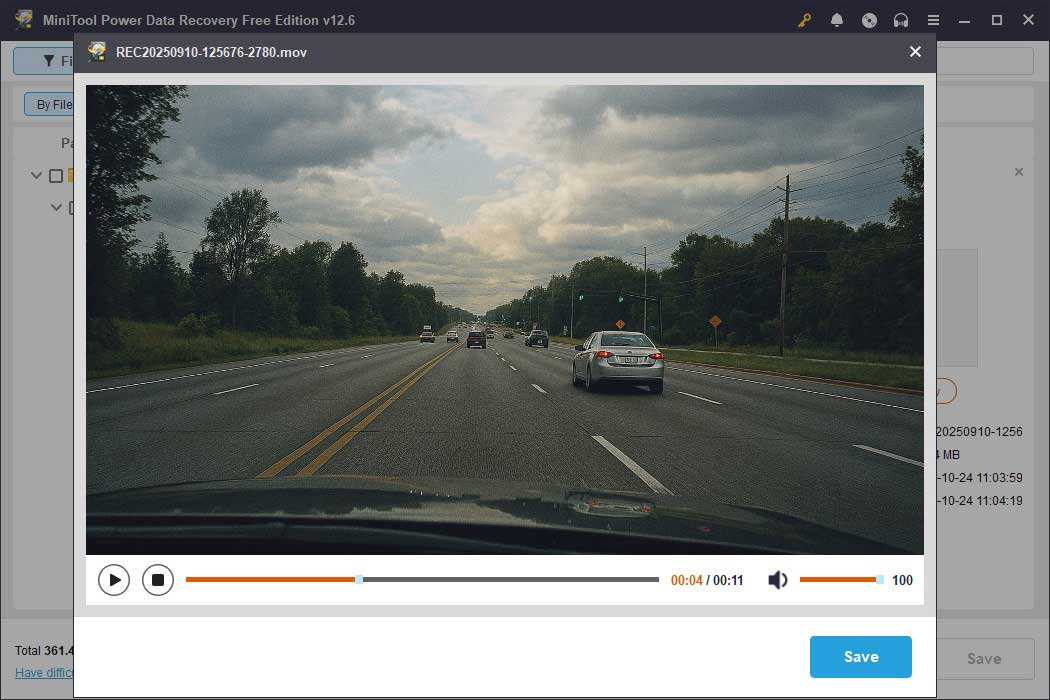
Step 3. Save wanted videos.
Once you have confirmed that the video is the one you want to recover, click Save and choose a location to store it directly from the preview window.
Alternatively, you can exit the preview window, select all the files you want to recover, and then click the Save button in the scan results window to save all selected videos at once.
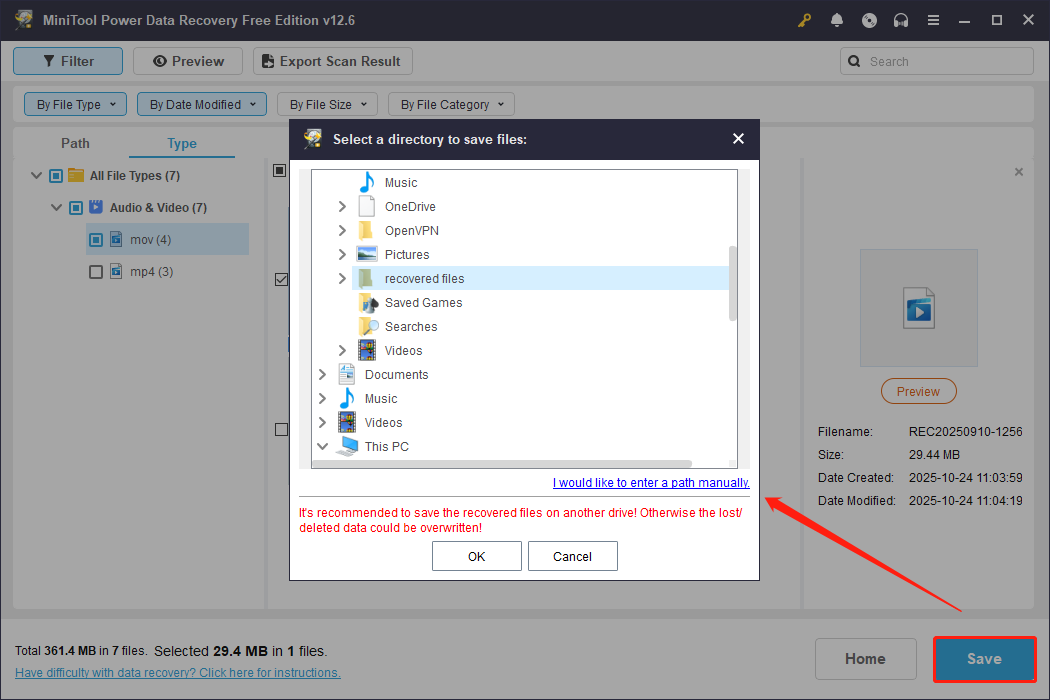
Once done, you can go to the selected location to view and use the recovered footage.
If you find MiniTool Power Data Recovery useful, please do not forget to share it with your friends.
Way 3. Seek Help From Data Recovery Agencies
If you cannot retrieve your videos by yourself, it may be time to consider professional help. Data recovery services specialize in handling complex data loss scenarios that software cannot fix.
Before choosing a service, make sure to check their reputation and reviews for data security.
This is all about how to recover deleted dash cam footage.
How to Protect Dash Cam Videos From Damage or Deletion
Once your dash cam footage has been successfully recovered, follow these steps to prevent future data loss.
Start by familiarizing yourself with the Protect or Lock button on your dash cam. Next, choose a high-quality SD card or USB drive and regularly format it to maintain disk health. Finally, do not forget to back up important videos to a secure location.
#1. Understand the Protect Button
As mentioned earlier, many dash cams automatically protect recordings using the G-sensor when your vehicle hits a bump or when parking mode is enabled.
However, some dash cams require you to press the Protect button manually during or after recording to lock the video. The Protect button is usually marked with an exclamation icon or a red triangle icon.
Protected files are stored in a separate folder and will not be overwritten until the allocated space for protected files is full.
Using the Protect function properly is a reliable way to ensure your important videos are safe.
#2. Use Reliable SD Cards
Low-quality SD cards are prone to data corruption and sudden failure, while high-quality cards are built with more durable components. This is especially important for continuous recording in dash cams.
How to choose a reliable SD card?
Stick to reputable brands such as SanDisk, Samsung, Kingston, Toshiba, and others.
If possible, choose a card with larger storage capacity. Larger cards can store more videos, allowing older recordings to be retained for a longer time.
#3. Format the SD Card Regularly
It is recommended to format your dash cam’s SD card regularly.
Over time, continuous recording can fragment the file system and lead to corrupted or missing videos. Formatting the card clears old fragments, ensuring stable recording and prolonging the card’s life.
#4. Update Dash Cam Firmware
Dash cam manufacturers often release firmware updates to fix bugs or improve performance. These updates are important to maintain security and ensure the device functions well.
So, you should regularly access your dash cam’s setup menu and check whether a firmware update is available. If an update is found, install it via the SD card or the dedicated dash cam software.
Your dash cam manufacturer should offer an official tutorial explaining how to perform the update. If you are using a Nextbase dash cam, check out this guide: How to Update Dash Cam Firmware.
#5. Back Up Important Videos
Having a backup is always considered the most important step when dealing with digital data, and dash cam footage is no exception.
When you have a backup, you can easily restore lost footage without using any data recovery software or paying any recovery costs.
How to back up dash cam footage? Here are three common options:
1. Computer or External Hard Drive
Remove the SD card from your dash cam, insert it into a card reader, and connect it to your computer. Then, copy and paste important video files to your computer’s internal hard drive or an external storage device.
It is recommended to use a dedicated drive for backups to minimize the risk of data loss or disk corruption.
2. Cloud Storage
There are many cloud services available, such as Dropbox, Google Drive, or OneDrive. Most of them offer free storage limits and paid plans for larger capacities. You can choose the one you prefer to store your videos.
In addition to providing backup, cloud storage allows you to access your footage from any device simply by logging into the same account.
3. Mobile Phone
Some dash cams come with a companion app that allows you to save footage directly to your smartphone.
If your dash cam supports this feature, you can easily back up important videos to your phone.
Conclusion
To sum up, this tutorial covers the common reasons for dash cam file loss, the steps to recover dash cam footage from an SD card/USB drive, and the best strategies to protect your footage.
Each part provides clear explanations and detailed instructions. So, simply follow the steps above to get your videos back.
If you have any questions when using MiniTool Power Data Recovery, please send us an email at [email protected].
How to Recover Dash Cam Videos FAQ
Therefore, how long your footage is stored depends on the size of your SD card, the video resolution, and the amount of footage being recorded.
According to Nextbase, you can typically store 1~20 hours of recordings.
Some dash cams have a parking mode feature that protects recordings when your car is parked. So, if you do not want to lose your videos, enable this feature or back up important files to another location manually.
Before the file is overwritten by new files, you can use data recovery software such as MiniTool Power Data Recovery to recover it.



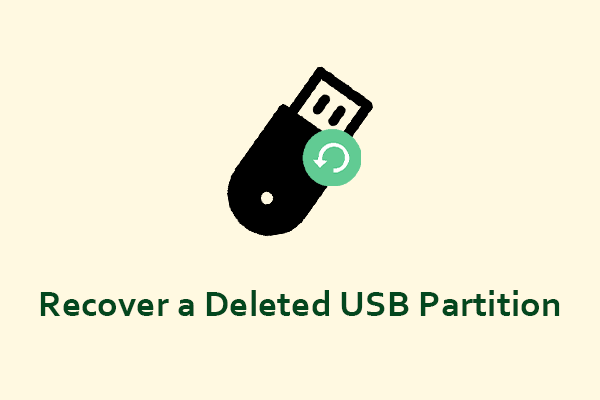
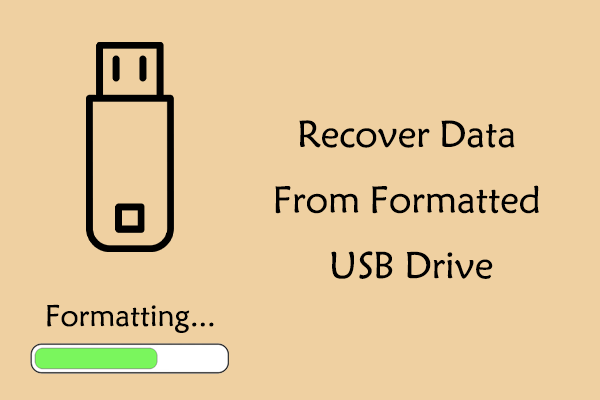
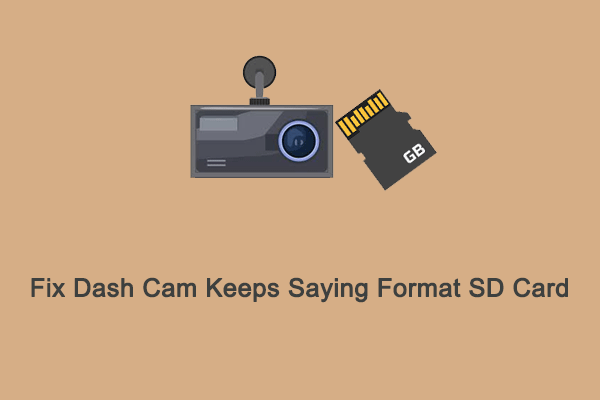
User Comments :